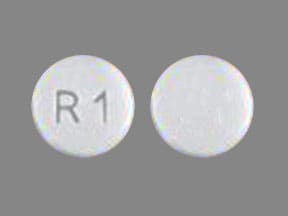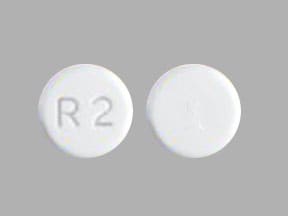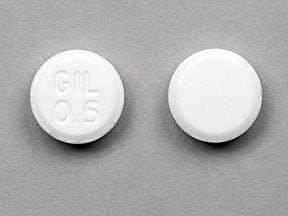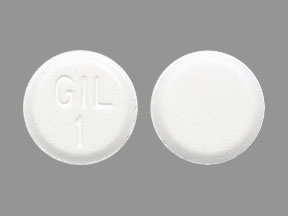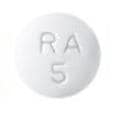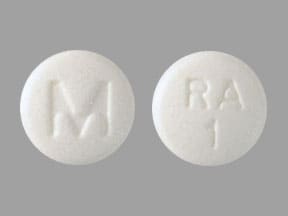Dosage Forms
Excipient information presented when available (limited, particularly for generics); consult specific product labeling.
Tablet, Oral:
Azilect: 0.5 mg, 1 mg
Generic: 0.5 mg, 1 mg
Pharmacology
Mechanism of Action
Potent, irreversible and selective inhibitor of brain monoamine oxidase (MAO) type B, which plays a major role in the catabolism of dopamine. Inhibition of dopamine depletion in the striatal region of the brain reduces the symptomatic motor deficits of Parkinson’s disease. There is also experimental evidence of rasagiline conferring neuroprotective effects (antioxidant, antiapoptotic), which may delay onset of symptoms and progression of neuronal deterioration.
Pharmacokinetics/Pharmacodynamics
Absorption
Rapid
Distribution
Vdss: 87 L
Metabolism
Hepatic N-dealkylation and/or hydroxylation via CYP1A2 to multiple inactive metabolites
Excretion
Urine (62%, <1% of total dose as unchanged drug); feces (7%)
Time to Peak
~1 hour
Duration of Action
~1 week (irreversible inhibition)
Half-Life Elimination
~3 hours (no correlation with biologic effect due to irreversible inhibition)
Protein Binding
88% to 94%,primarily to albumin
Use in Specific Populations
Special Populations: Hepatic Function Impairment
In patients with mild hepatic impairment (Child-Pugh score 5 to 6), AUC and Cmax are increased 2- and 1.4-fold, respectively. In patients with moderate hepatic impairment (Child-Pugh score 7 to 9), the AUC and Cmax are increased 7- and 2-fold, respectively.
Use: Labeled Indications
Parkinson disease: Treatment of Parkinson disease
Contraindications
Concomitant use of an MAO inhibitor (including selective MAO-B inhibitors), meperidine, methadone, propoxyphene, or tramadol within 14 days of rasagiline; concomitant use with cyclobenzaprine, dextromethorphan, or St John’s wort
Dosage and Administration
Dosing: Adult
Parkinson disease: Oral:
Monotherapy or adjunctive therapy (not including levodopa): 1 mg once daily (maximum: 1 mg/day).
Adjunctive therapy with levodopa: Initial: 0.5 mg once daily; may increase to 1 mg once daily based on response and tolerability (maximum: 1 mg/day).
Note: When added to existing levodopa therapy, a dose reduction of levodopa may be required to avoid exacerbation of dyskinesias; typical dose reductions of ~9% to 13% were employed in clinical trials.
Dosing: Geriatric
Refer to adult dosing.
Administration
Administer without regard to meals.
Dietary Considerations
Avoid products containing high amounts of tyramine (>150 mg), such as aged cheeses (eg, Stilton cheese). Restriction of tyramine-containing products with lower amounts (<150 mg) of tyramine is not necessary in patients taking recommended doses. Some examples of tyramine-containing products include aged or matured cheese, air-dried or cured meats (including sausages and salamis), fava or broad bean pods, tap/draft beers, Marmite concentrate, sauerkraut, soy sauce and other soybean condiments. Food’s freshness is also an important concern; improperly stored or spoiled food can create an environment where tyramine concentrations may increase.
Storage
Store at 25°C (77°F); excursions permitted to 15°C to 30°C (59°F to 86°F).
Rasagiline Images
Drug Interactions
Alcohol (Ethyl): May enhance the adverse/toxic effect of Monoamine Oxidase Inhibitors. Avoid combination
Alfuzosin: May enhance the hypotensive effect of Blood Pressure Lowering Agents. Monitor therapy
Alpha-/Beta-Agonists (Indirect-Acting): Monoamine Oxidase Inhibitors may enhance the hypertensive effect of Alpha-/Beta-Agonists (Indirect-Acting). While linezolid is expected to interact via this mechanism, management recommendations differ from other monoamine oxidase inhibitors. Refer to linezolid specific monographs for details. Avoid combination
Alpha1-Agonists: Monoamine Oxidase Inhibitors may enhance the hypertensive effect of Alpha1-Agonists. While linezolid is expected to interact via this mechanism, management recommendations differ from other monoamine oxidase inhibitors. Refer to linezolid specific monographs for details. Avoid combination
Amifampridine: Agents With Seizure Threshold Lowering Potential may enhance the neuroexcitatory and/or seizure-potentiating effect of Amifampridine. Monitor therapy
Amifostine: Blood Pressure Lowering Agents may enhance the hypotensive effect of Amifostine. Management: When amifostine is used at chemotherapy doses, blood pressure lowering medications should be withheld for 24 hours prior to amifostine administration. If blood pressure lowering therapy cannot be withheld, amifostine should not be administered. Consider therapy modification
Amphetamines: Monoamine Oxidase Inhibitors may enhance the hypertensive effect of Amphetamines. While linezolid and tedizolid may interact via this mechanism, management recommendations differ from other monoamine oxidase inhibitors. Refer to monographs specific to those agents for details. Avoid combination
Antipsychotic Agents (Second Generation [Atypical]): Blood Pressure Lowering Agents may enhance the hypotensive effect of Antipsychotic Agents (Second Generation [Atypical]). Monitor therapy
Apraclonidine: Monoamine Oxidase Inhibitors may enhance the adverse/toxic effect of Apraclonidine. Monoamine Oxidase Inhibitors may increase the serum concentration of Apraclonidine. Avoid combination
AtoMOXetine: Monoamine Oxidase Inhibitors may enhance the neurotoxic (central) effect of AtoMOXetine. Avoid combination
Atropine (Ophthalmic): Monoamine Oxidase Inhibitors may enhance the hypertensive effect of Atropine (Ophthalmic). Avoid combination
Barbiturates: May enhance the hypotensive effect of Blood Pressure Lowering Agents. Monitor therapy
Benperidol: May enhance the hypotensive effect of Blood Pressure Lowering Agents. Monitor therapy
Benzhydrocodone: May enhance the serotonergic effect of Monoamine Oxidase Inhibitors. This could result in serotonin syndrome. Management: The use of benzhydrocodone is not recommended for patients taking monoamine oxidase inhibitors (MAOIs) or within 14 days of MAOI discontinuation. Consider therapy modification
Beta2-Agonists: Monoamine Oxidase Inhibitors may enhance the adverse/toxic effect of Beta2-Agonists. Monitor therapy
Betahistine: Monoamine Oxidase Inhibitors may increase the serum concentration of Betahistine. Monitor therapy
Bezafibrate: Monoamine Oxidase Inhibitors may enhance the adverse/toxic effect of Bezafibrate. Avoid combination
Blood Glucose Lowering Agents: Monoamine Oxidase Inhibitors may enhance the hypoglycemic effect of Blood Glucose Lowering Agents. Monitor therapy
Blood Pressure Lowering Agents: May enhance the hypotensive effect of Hypotension-Associated Agents. Monitor therapy
Brimonidine (Ophthalmic): Monoamine Oxidase Inhibitors may enhance the adverse/toxic effect of Brimonidine (Ophthalmic). Monoamine Oxidase Inhibitors may increase the serum concentration of Brimonidine (Ophthalmic). Monitor therapy
Brimonidine (Topical): Monoamine Oxidase Inhibitors may enhance the adverse/toxic effect of Brimonidine (Topical). Monoamine Oxidase Inhibitors may increase the serum concentration of Brimonidine (Topical). Monitor therapy
Brimonidine (Topical): May enhance the hypotensive effect of Blood Pressure Lowering Agents. Monitor therapy
Bromperidol: Blood Pressure Lowering Agents may enhance the hypotensive effect of Bromperidol. Bromperidol may diminish the hypotensive effect of Blood Pressure Lowering Agents. Avoid combination
Buprenorphine: May enhance the adverse/toxic effect of Monoamine Oxidase Inhibitors. Avoid combination
BuPROPion: Monoamine Oxidase Inhibitors may enhance the hypertensive effect of BuPROPion. Avoid combination
CarBAMazepine: May enhance the adverse/toxic effect of Monoamine Oxidase Inhibitors. Management: Avoid concurrent use of carbamazepine during, or within 14 days of discontinuing, treatment with a monoamine oxidase inhibitor. Avoid combination
Cerebrolysin: May enhance the adverse/toxic effect of Monoamine Oxidase Inhibitors. Monitor therapy
Chlorphenesin Carbamate: May enhance the adverse/toxic effect of Monoamine Oxidase Inhibitors. Monitor therapy
Cocaine (Topical): May enhance the adverse/toxic effect of Monoamine Oxidase Inhibitors. Monitor therapy
Codeine: Monoamine Oxidase Inhibitors may enhance the adverse/toxic effect of Codeine. Avoid combination
COMT Inhibitors: May enhance the adverse/toxic effect of Monoamine Oxidase Inhibitors. Consider therapy modification
Cyclobenzaprine: May enhance the serotonergic effect of Monoamine Oxidase Inhibitors. This could result in serotonin syndrome. Avoid combination
CYP1A2 Inhibitors (Moderate): May increase the serum concentration of Rasagiline. Management: Limit rasagiline dose to 0.5 mg once daily in patients taking moderate CYP1A2 inhibitors. Consider therapy modification
Cyproheptadine: Monoamine Oxidase Inhibitors may enhance the anticholinergic effect of Cyproheptadine. Cyproheptadine may diminish the serotonergic effect of Monoamine Oxidase Inhibitors. Avoid combination
Deutetrabenazine: Monoamine Oxidase Inhibitors may enhance the adverse/toxic effect of Deutetrabenazine. Avoid combination
Dexmethylphenidate: Monoamine Oxidase Inhibitors may enhance the hypertensive effect of Dexmethylphenidate. Avoid combination
Dextromethorphan: Monoamine Oxidase Inhibitors may enhance the serotonergic effect of Dextromethorphan. This may cause serotonin syndrome. Avoid combination
Diazoxide: May enhance the hypotensive effect of Blood Pressure Lowering Agents. Monitor therapy
Diethylpropion: Monoamine Oxidase Inhibitors may enhance the hypertensive effect of Diethylpropion. Avoid combination
Dihydrocodeine: May enhance the serotonergic effect of Monoamine Oxidase Inhibitors. This could result in serotonin syndrome. Monitor therapy
Diphenoxylate: May enhance the hypertensive effect of Monoamine Oxidase Inhibitors. Avoid combination
Domperidone: Monoamine Oxidase Inhibitors may enhance the adverse/toxic effect of Domperidone. Monoamine Oxidase Inhibitors may diminish the therapeutic effect of Domperidone. Domperidone may diminish the therapeutic effect of Monoamine Oxidase Inhibitors. Monitor therapy
DOPamine: Monoamine Oxidase Inhibitors may enhance the hypertensive effect of DOPamine. Management: Initiate dopamine at no greater than one-tenth (1/10) of the usual dose in patients who are taking (or have taken within the last 2 to 3 weeks) monoamine oxidase inhibitors. Monitor for an exaggerated hypertensive response to dopamine. Consider therapy modification
Doxapram: Monoamine Oxidase Inhibitors may enhance the hypertensive effect of Doxapram. Monitor therapy
EPINEPHrine (Nasal): Monoamine Oxidase Inhibitors may enhance the hypertensive effect of EPINEPHrine (Nasal). Monitor therapy
EPINEPHrine (Oral Inhalation): Monoamine Oxidase Inhibitors may enhance the hypertensive effect of EPINEPHrine (Oral Inhalation). Avoid combination
Epinephrine (Racemic): Monoamine Oxidase Inhibitors may enhance the hypertensive effect of Epinephrine (Racemic). Monitor therapy
EPINEPHrine (Systemic): Monoamine Oxidase Inhibitors may enhance the hypertensive effect of EPINEPHrine (Systemic). Monitor therapy
Esketamine: May enhance the hypertensive effect of Monoamine Oxidase Inhibitors. Monitor therapy
FentaNYL: May enhance the serotonergic effect of Monoamine Oxidase Inhibitors (Type B). This could result in serotonin syndrome. Avoid combination
FluvoxaMINE: May enhance the serotonergic effect of Rasagiline. This could result in serotonin syndrome. FluvoxaMINE may increase the serum concentration of Rasagiline. Avoid combination
Guanethidine: May enhance the adverse/toxic effect of Monoamine Oxidase Inhibitors. Avoid combination
Herbs (Hypotensive Properties): May enhance the hypotensive effect of Blood Pressure Lowering Agents. Monitor therapy
Heroin: Monoamine Oxidase Inhibitors may enhance the adverse/toxic effect of Heroin. Avoid combination
HYDROcodone: Monoamine Oxidase Inhibitors may enhance the adverse/toxic effect of HYDROcodone. Management: Consider alternatives to this combination when possible. Consider therapy modification
HYDROmorphone: Monoamine Oxidase Inhibitors may enhance the adverse/toxic effect of HYDROmorphone. Avoid combination
Hypotension-Associated Agents: Blood Pressure Lowering Agents may enhance the hypotensive effect of Hypotension-Associated Agents. Monitor therapy
Indoramin: Monoamine Oxidase Inhibitors may enhance the hypotensive effect of Indoramin. Avoid combination
Iobenguane Radiopharmaceutical Products: Monoamine Oxidase Inhibitors may diminish the therapeutic effect of Iobenguane Radiopharmaceutical Products. Management: Discontinue all drugs that may inhibit or interfere with catecholamine transport or uptake for at least 5 biological half-lives before iobenguane administration. Do not administer these drugs until at least 7 days after each iobenguane dose. Avoid combination
Iohexol: Agents With Seizure Threshold Lowering Potential may enhance the adverse/toxic effect of Iohexol. Specifically, the risk for seizures may be increased. Management: Discontinue agents that may lower the seizure threshold 48 hours prior to intrathecal use of iohexol. Wait at least 24 hours after the procedure to resume such agents. In nonelective procedures, consider use of prophylactic anticonvulsants. Consider therapy modification
Iomeprol: Agents With Seizure Threshold Lowering Potential may enhance the adverse/toxic effect of Iomeprol. Specifically, the risk for seizures may be increased. Management: Discontinue agents that may lower the seizure threshold 48 hours prior to intrathecal use of iomeprol. Wait at least 24 hours after the procedure to resume such agents. In nonelective procedures, consider use of prophylactic anticonvulsants. Consider therapy modification
Iopamidol: Agents With Seizure Threshold Lowering Potential may enhance the adverse/toxic effect of Iopamidol. Specifically, the risk for seizures may be increased. Management: Discontinue agents that may lower the seizure threshold 48 hours prior to intrathecal use of iopamidol. Wait at least 24 hours after the procedure to resume such agents. In nonelective procedures, consider use of prophylactic anticonvulsants. Consider therapy modification
Isometheptene: Monoamine Oxidase Inhibitors may enhance the adverse/toxic effect of Isometheptene. Avoid combination
Levodopa-Containing Products: Blood Pressure Lowering Agents may enhance the hypotensive effect of Levodopa-Containing Products. Monitor therapy
Levodopa-Containing Products: May enhance the orthostatic hypotensive effect of Monoamine Oxidase Inhibitors (Type B). Monitor therapy
Levomethadone: May enhance the adverse/toxic effect of Monoamine Oxidase Inhibitors. Avoid combination
Levonordefrin: Monoamine Oxidase Inhibitors may enhance the hypertensive effect of Levonordefrin. Avoid combination
Linezolid: May enhance the serotonergic effect of Monoamine Oxidase Inhibitors (Type B). This could result in serotonin syndrome. Avoid combination
Lormetazepam: May enhance the hypotensive effect of Blood Pressure Lowering Agents. Monitor therapy
Maprotiline: May enhance the adverse/toxic effect of Monoamine Oxidase Inhibitors. Avoid combination
Meptazinol: Monoamine Oxidase Inhibitors may enhance the adverse/toxic effect of Meptazinol. Avoid combination
Mequitazine: Monoamine Oxidase Inhibitors may enhance the anticholinergic effect of Mequitazine. Avoid combination
Metaraminol: Monoamine Oxidase Inhibitors may enhance the hypertensive effect of Metaraminol. Monitor therapy
Methadone: May enhance the serotonergic effect of Monoamine Oxidase Inhibitors. This could result in serotonin syndrome. Avoid combination
Methyldopa: Monoamine Oxidase Inhibitors may enhance the adverse/toxic effect of Methyldopa. Avoid combination
Methylene Blue: Monoamine Oxidase Inhibitors (Type B) may enhance the serotonergic effect of Methylene Blue. This could result in serotonin syndrome. Avoid combination
Methylphenidate: Monoamine Oxidase Inhibitors may enhance the hypertensive effect of Methylphenidate. Avoid combination
Metoclopramide: May enhance the hypertensive effect of Monoamine Oxidase Inhibitors. Avoid combination
Mianserin: Monoamine Oxidase Inhibitors may enhance the neurotoxic effect of Mianserin. Avoid combination
Molsidomine: May enhance the hypotensive effect of Blood Pressure Lowering Agents. Monitor therapy
Monoamine Oxidase Inhibitors (Antidepressant): May enhance the hypertensive effect of Monoamine Oxidase Inhibitors (Type B). Monoamine Oxidase Inhibitors (Antidepressant) may enhance the serotonergic effect of Monoamine Oxidase Inhibitors (Type B). This could result in serotonin syndrome. Avoid combination
Monoamine Oxidase Inhibitors (Type B): May enhance the serotonergic effect of other Monoamine Oxidase Inhibitors (Type B). This could result in serotonin syndrome. Avoid combination
Morphine (Systemic): Monoamine Oxidase Inhibitors may enhance the adverse/toxic effect of Morphine (Systemic). Avoid combination
Naftopidil: May enhance the hypotensive effect of Blood Pressure Lowering Agents. Monitor therapy
Nefazodone: Rasagiline may enhance the serotonergic effect of Nefazodone. This could result in serotonin syndrome. Avoid combination
Nefopam: Monoamine Oxidase Inhibitors may enhance the adverse/toxic effect of Nefopam. Avoid combination
Nicergoline: May enhance the hypotensive effect of Blood Pressure Lowering Agents. Monitor therapy
Nicorandil: May enhance the hypotensive effect of Blood Pressure Lowering Agents. Monitor therapy
Nitroprusside: Blood Pressure Lowering Agents may enhance the hypotensive effect of Nitroprusside. Monitor therapy
Norepinephrine: Monoamine Oxidase Inhibitors may enhance the hypertensive effect of Norepinephrine. Monitor therapy
Normethadone: Monoamine Oxidase Inhibitors may enhance the adverse/toxic effect of Normethadone. Avoid combination
Obinutuzumab: May enhance the hypotensive effect of Blood Pressure Lowering Agents. Management: Consider temporarily withholding blood pressure lowering medications beginning 12 hours prior to obinutuzumab infusion and continuing until 1 hour after the end of the infusion. Consider therapy modification
Opium: Monoamine Oxidase Inhibitors may enhance the adverse/toxic effect of Opium. Avoid combination
OxyCODONE: May enhance the serotonergic effect of Monoamine Oxidase Inhibitors. This could result in serotonin syndrome. Avoid combination
OxyMORphone: May enhance the adverse/toxic effect of Monoamine Oxidase Inhibitors. Avoid combination
Pentoxifylline: May enhance the hypotensive effect of Blood Pressure Lowering Agents. Monitor therapy
Pheniramine: May enhance the anticholinergic effect of Monoamine Oxidase Inhibitors. Avoid combination
Pholcodine: May enhance the serotonergic effect of Monoamine Oxidase Inhibitors. This could result in serotonin syndrome. Avoid combination
Phosphodiesterase 5 Inhibitors: May enhance the hypotensive effect of Blood Pressure Lowering Agents. Monitor therapy
Pipamperone [INT]: May diminish the therapeutic effect of Anti-Parkinson Agents (Monoamine Oxidase Inhibitor). Anti-Parkinson Agents (Monoamine Oxidase Inhibitor) may diminish the therapeutic effect of Pipamperone [INT]. Monitor therapy
Pizotifen: Monoamine Oxidase Inhibitors may enhance the anticholinergic effect of Pizotifen. Avoid combination
Prostacyclin Analogues: May enhance the hypotensive effect of Blood Pressure Lowering Agents. Monitor therapy
Quinagolide: May enhance the hypotensive effect of Blood Pressure Lowering Agents. Monitor therapy
Reboxetine: Monoamine Oxidase Inhibitors may enhance the adverse/toxic effect of Reboxetine. Avoid combination
Remifentanil: Monoamine Oxidase Inhibitors may enhance the adverse/toxic effect of Remifentanil. Specifically, the risk for opioid toxicity (eg, respiratory depression) may be increased. Remifentanil may enhance the serotonergic effect of Monoamine Oxidase Inhibitors. This could result in serotonin syndrome. Management: The use of remifentanil is not recommended for patients taking monoamine oxidase inhibitors (MAOIs) or within 14 days of MAOI discontinuation. Consider therapy modification
Reserpine: Monoamine Oxidase Inhibitors may enhance the adverse/toxic effect of Reserpine. Existing MAOI therapy can result in paradoxical effects of added reserpine (e.g., excitation, hypertension). Management: Monoamine oxidase inhibitors (MAOIs) should be avoided or used with great caution in patients who are also receiving reserpine. Consider therapy modification
Selective Serotonin Reuptake Inhibitors: May enhance the serotonergic effect of Rasagiline. This could result in serotonin syndrome. Exceptions: FluvoxaMINE. Avoid combination
Serotonergic Agents (High Risk, Miscellaneous): Monoamine Oxidase Inhibitors (Type B) may enhance the serotonergic effect of Serotonergic Agents (High Risk, Miscellaneous). This could result in serotonin syndrome. Avoid combination
Serotonergic Agents (Moderate Risk, Miscellaneous): Monoamine Oxidase Inhibitors (Type B) may enhance the serotonergic effect of Serotonergic Agents (Moderate Risk, Miscellaneous). This could result in serotonin syndrome. Management: Monitor for signs and symptoms of serotonin syndrome/serotonin toxicity (eg, hyperreflexia, clonus, hyperthermia, diaphoresis, tremor, autonomic instability, mental status changes) when these agents are combined. Exceptions: St John's Wort. Monitor therapy
Serotonergic Non-Opioid CNS Depressants: Rasagiline may enhance the serotonergic effect of Serotonergic Non-Opioid CNS Depressants. This could result in serotonin syndrome. Avoid combination
Serotonergic Opioids (High Risk): May enhance the serotonergic effect of Monoamine Oxidase Inhibitors (Type B). This could result in serotonin syndrome. Exceptions: FentaNYL. Avoid combination
Serotonin/Norepinephrine Reuptake Inhibitors: Rasagiline may enhance the serotonergic effect of Serotonin/Norepinephrine Reuptake Inhibitors. This could result in serotonin syndrome. Avoid combination
Solriamfetol: Monoamine Oxidase Inhibitors may enhance the hypertensive effect of Solriamfetol. Avoid combination
St John's Wort: Monoamine Oxidase Inhibitors (Type B) may enhance the serotonergic effect of St John's Wort. This could result in serotonin syndrome. Avoid combination
SUFentanil: May enhance the adverse/toxic effect of Monoamine Oxidase Inhibitors. Specifically, the risk for serotonin syndrome or opioid toxicities (eg, respiratory depression, coma) may be increased. Management: Sufentanil should not be used with monoamine oxidase (MAO) inhibitors (or within 14 days of stopping an MAO inhibitor) due to the potential for serotonin syndrome and/or excessive CNS depression. Avoid combination
Tapentadol: May enhance the adverse/toxic effect of Monoamine Oxidase Inhibitors. Specifically, the additive effects of norepinephrine may lead to adverse cardiovascular effects. Tapentadol may enhance the serotonergic effect of Monoamine Oxidase Inhibitors. This could result in serotonin syndrome. Avoid combination
Tetrabenazine: May enhance the adverse/toxic effect of Monoamine Oxidase Inhibitors. Avoid combination
Tetrahydrozoline (Nasal): Monoamine Oxidase Inhibitors may enhance the hypertensive effect of Tetrahydrozoline (Nasal). Avoid combination
Tricyclic Antidepressants: Rasagiline may enhance the serotonergic effect of Tricyclic Antidepressants. This could result in serotonin syndrome. Avoid combination
Valbenazine: May enhance the adverse/toxic effect of Monoamine Oxidase Inhibitors. Avoid combination
Adverse Reactions
Unless otherwise noted, the following adverse reactions are as reported for monotherapy. Spectrum of adverse events was generally similar with adjunctive therapy, though the incidence tended to be higher. Frequency not always defined.
>10%:
Cardiovascular: Orthostatic hypotension (adjunctive therapy 3% to 13%, adjunctive therapy dose-related 6% to 9%; adjunctive therapy, 1 mg dose 3%; mild to moderate systolic blood pressure decrease [≥20 mmHg], 1 mg dose 44%; mild to moderate diastolic blood pressure decrease [≥10 mmHg], 1 mg dose 40%; severe diastolic blood pressure decrease [≥20 mmHg], 1 mg dose 9%; severe systolic blood pressure decrease [≥40 mmHg], 1 mg dose 7%), hypotension (3% post-treatment [systolic <90 mmHg or diastolic <50 mmHg combined with significant decrease from baseline, systolic >30 mmHg or diastolic >20 mmHg])
Central nervous system: Headache (14%; adjunctive therapy 6% to 11%)
Gastrointestinal: Nausea (adjunctive therapy 6% to 12%)
Neuromuscular & skeletal: Dyskinesia (adjunctive therapy 18%)
Miscellaneous: Trauma (adjunctive therapy 8% to 12%)
1% to 10%:
Cardiovascular: Peripheral edema (7%), increased blood pressure (adjunctive therapy, significant increase, >180 mmHg systolic or >100 mmHg diastolic 4%; adjunctive therapy, post-treatment [>180 mmHg systolic or >100 mmHg diastolic combined with significant increase from baseline >30 mmHg systolic or >20 mmHg diastolic] 2%), angina, bundle branch block, chest pain
Central nervous system: Dizziness (7%), drowsiness (adjunctive therapy 4% to 6%), ataxia (adjunctive therapy 3% to 6%), depression (5%), falling (5%; adjunctive therapy 6% to 12%), abnormal dreams (adjunctive therapy 1% to 4%), dystonia (adjunctive therapy 2% to 3%), malaise (2%), paresthesia (2%; adjunctive therapy 2% to 5%), insomnia (adjunctive therapy 4%), hallucinations (1%; adjunctive therapy 4% to 5%), myasthenia (adjunctive therapy 2%), vertigo (2%), anxiety
Dermatologic: Skin rash (adjunctive therapy 3% to 6%), ecchymosis (2%; adjunctive therapy 2% to 5%), diaphoresis (adjunctive therapy 2% to 3%), alopecia, skin carcinoma, vesiculobullous rash
Endocrine & metabolic: Weight loss (adjunctive therapy, dose-related 2% to 9%), impotence, libido decreased
Gastrointestinal: Constipation (adjunctive therapy 4% to 9%), dyspepsia (7%; adjunctive therapy 4% to 5%), diarrhea (adjunctive therapy 5% to 7%), vomiting (adjunctive therapy 4% to 7%), xerostomia (adjunctive therapy, dose-related 2% to 6%), abdominal pain (adjunctive therapy 2% to 5%), anorexia (adjunctive therapy 2% to 5%), gastroenteritis (3%), gingivitis (adjunctive therapy 1% to 2%), hernia (adjunctive therapy 1% to 2%), gastrointestinal hemorrhage
Genitourinary: Hematuria, urinary incontinence
Hematologic and oncologic: Hemorrhage (adjunctive therapy 1% to 2%), leukopenia
Hepatic: Liver function tests increased
Infection: Infection (adjunctive therapy 2% to 3%)
Neuromuscular & skeletal: Arthralgia (7%; adjunctive therapy 5% to 8%), back pain (adjunctive therapy 4%), neck pain (2%; adjunctive therapy 1% to 3%), tenosynovitis (adjunctive therapy 1% to 3%), arthritis (2%), abnormal gait, hyperkinesias, hypertonia, neuropathy, weakness
Ophthalmic: Conjunctivitis (3%)
Renal: Albuminuria
Respiratory: Flu-like symptoms (5%), dyspnea (adjunctive therapy 3% to 5%), cough (adjunctive therapy 4%), upper respiratory tract infection (adjunctive therapy 4%), rhinitis (3%), asthma
Miscellaneous: Fever (3%), allergic reaction
<1%, postmarketing, case reports and/or frequency not defined: Abnormal behavior, abnormality in thinking, acute kidney failure, aggressive behavior, agitation, altered sense of smell, amyotrophy, aphasia, apnea, arterial thrombosis, atrial arrhythmia, atrioventricular block, bigeminy, blepharitis, blepharoptosis, blindness, cardiac failure, cerebral hemorrhage, cerebral ischemia, confusion, deafness, deep vein thrombophlebitis, delirium, delusions, diplopia, disorientation, dysautonomia, dysesthesia, emphysema, esophageal ulcer, exacerbation of hypertension, excessive daytime sleepiness (including during operation of motor vehicles), exfoliative dermatitis, facial paralysis, gastric ulcer, genitourinary disorders, glaucoma, gynecomastia, hematemesis, hemiplegia, hostility, hypocalcemia, hypotension (while supine), impulse control disorder (pathological gambling, hypersexuality, intense urges to spend money, binge eating, and/or other intense urges and the inability to control the urges), interstitial pneumonitis, intestinal obstruction, intestinal perforation, intestinal stenosis, jaundice, keratitis, large intestine perforation, laryngeal edema, laryngismus, leukoderma, leukorrhea, macrocytic anemia, manic depressive reaction, mania, megacolon, menstrual abnormalities, myelitis, myocardial infarction, nephrolithiasis, neuralgia, neuritis, (a complex resembling) neuroleptic malignant syndrome (associated with rapid dose reduction, withdrawal of or changes in medication; includes autonomic insufficiency, hyperthermia, impaired consciousness, muscle rigidity), nocturia, oral paresthesia, osteonecrosis, paranoia, personality disorder, pleural effusion, pneumothorax, polyuria, psychiatric disturbance (new or worsening mental status and behavioral changes that may be severe, including psychotic-like behavior during or after starting or increasing doses), psychoneurosis, psychotic symptoms, psychotic depression, pulmonary fibrosis, purpura, retinal degeneration, retinal detachment, seizure, strabismus, stupor, thrombocythemia, tongue edema, ventricular fibrillation, ventricular tachycardia, vestibular disturbance, visual field defect, vulvovaginal candidiasis
Warnings/Precautions
Concerns related to adverse effects:
- CNS effects: May cause new or worsening mental status and behavioral changes, which may be severe, including paranoid ideation, delusions, hallucinations, confusion, psychotic-like behavior, disorientation, aggressive behavior, agitation, and delirium after starting or increasing the dose of rasagiline. Monitor for these symptoms. If symptoms develop, consider dose reduction or discontinue of therapy.
- Dyskinesia: Dyskinesia, exacerbation of preexisting dyskinesia, or increased dopaminergic side effects may occur when used as an adjunct to levodopa. Decreasing the dose of levodopa may mitigate these side effects.
- Impulse control disorders: Dopaminergic agents used for Parkinson disease have been associated with compulsive behaviors and/or loss of impulse control, which has manifested as pathological gambling, libido increases (hypersexuality), uncontrolled spending of money, binge eating, and/or other intense urges. Causality has not been established, and controversy exists as to whether this phenomenon is related to the underlying disease, prior behaviors/addictions, and/or drug therapy. Dose reduction or discontinuation of therapy has been reported to reverse these behaviors in some, but not all, cases.
- Hypertension: May cause exacerbation of hypertension; monitor for new onset hypertension or hypertension not adequately controlled after starting rasagiline. Medication adjustment may be necessary if blood pressure elevation is sustained.
- Melanoma: Risk of melanoma may be increased with rasagiline, although increased risk has been associated with Parkinson disease itself; patients should have regular and frequent skin examinations.
- Orthostatic hypotension: May cause orthostatic hypotension, particularly in combination with levodopa. Orthostatic hypotension occurs most frequently during the first 2 months of therapy and decreases over time.
- Serotonin syndrome: Serotonin syndrome (SS) has been reported with concomitant antidepressant (eg, SSRI, SNRI, TCA, tetracyclic and triazolopyridine antidepressants) use; concomitant use is not recommended within 14 days of rasagiline administration (within 5 weeks for antidepressants with long half-lives such as fluoxetine). SS has also been reported with concomitant use of MAO inhibitors (including selective MAO-B inhibitors), meperidine, methadone, propoxyphene, and tramadol; concomitant use within 14 days of rasagiline administration is contraindicated. Monitor patients closely. The diagnosis of SS can be made using the Hunter Serotonin Toxicity Criteria (Dunkley 2003). Discontinue treatment (and any concomitant antidepressants) immediately if signs/symptoms arise.
- Somnolence: Somnolence and falling asleep while engaged in activities of daily living (including operation of motor vehicles) have been reported; some cases reported that there were no warning signs for the onset of symptoms. Symptom onset may occur well after initiation of treatment; some events have occurred >1 year after initiation of rasagiline. Prior to treatment initiation, evaluate for factors that may increase these risks such as concomitant sedating medications, the presence of sleep disorders, and concomitant medications that increase rasagiline plasma levels (eg, ciprofloxacin). Monitor for drowsiness or sleepiness. If significant daytime sleepiness or episodes of falling asleep during activities that require active participation occur (eg, driving, conversations, eating), discontinue rasagiline. There is insufficient information to suggest that dose reductions will eliminate these symptoms. If therapy is continued, advise patient to avoid driving and other potentially dangerous activities.
Disease-related concerns:
- Hepatic impairment: Use with caution in patients with mild hepatic impairment; dose reduction recommended. Avoid use in patients with moderate to severe impairment.
- Psychotic disorders: Avoidance of use is recommended in patients with major psychotic disorder due to the risk of exacerbating psychosis with an increase in central dopaminergic tone. Many treatments for psychosis that decrease central dopaminergic tone may also decrease the effectiveness of rasagiline.
Concurrent drug therapy issues:
- Drug-drug interactions: Potentially significant interactions may exist, requiring dose or frequency adjustment, additional monitoring, and/or selection of alternative therapy. Consult drug interactions database for more detailed information.
Special populations:
- Surgical patients: According to many of the MOA inhibitor manufacturers, use within 10 days prior to elective surgery is contraindicated. The decision to continue or withhold MAO inhibitors must be done in collaboration with the patient's psychiatrist. Currently, an MAO-safe anesthetic technique which excludes the use of meperidine and indirect-acting adrenergic agonists is recommended for patients requiring continued MAO inhibitor therapy (Huyse 2006).
Other warnings/precautions:
- Antiparkinsonian discontinuation syndrome: Abrupt discontinuation or interruption of antiparkinsonian therapy has been associated with a discontinuation syndrome, which may resemble neuroleptic malignant syndrome; symptoms may include elevated temperature, muscular rigidity, altered consciousness, and autonomic instability.
- Tyramine-containing products: In patients taking recommended doses of rasagiline, dietary restriction of most tyramine-containing products is not necessary; however, certain foods (eg, aged cheeses) may contain high amounts (>150 mg) of tyramine and could lead to hypertensive crisis. Avoid concomitant use with foods high in tyramine. Rasagiline is a selective inhibitor of MAO-B at the recommended doses; however, MAO-B selectivity diminishes in a dose-related manner above the recommended daily doses.
Monitoring Parameters
Blood pressure (baseline, at periodic intervals, and as clinically indicated); liver and renal function (baseline and as clinically indicated); skin examination for presence of melanoma (at periodic intervals).
Pregnancy
Pregnancy Considerations
Adverse effects have been observed in animal reproduction studies. Information related to rasagiline use in pregnancy is limited (Seier 2017; Tüfekçioğlu 2018).
Patient Education
What is this drug used for?
- It is used to treat Parkinson disease.
Frequently reported side effects of this drug
- Flu-like symptoms
- Nausea
- Vomiting
- Constipation
- Diarrhea
- Dry mouth
- Lack of appetite
- Abdominal pain
- Weight loss
- Nightmares
- Bruising
- Joint pain
Other side effects of this drug: Talk with your doctor right away if you have any of these signs of:
- Severe headache
- Narcolepsy
- Severe fatigue
- Abnormal movements
- Twitching
- Change in balance
- difficulty swallowing
- Difficulty speaking
- Tremors
- Difficulty moving
- Rigidity
- Severe dizziness
- Passing out
- Vision changes
- Uncontrollable urges
- Skin growths
- Mole changes
- Sensing things that seem real but are not
- Behavioral changes
- Mood changes
- Shortness of breath
- Burning or numbness feeling
- Swelling of arms or legs
- Serotonin syndrome like dizziness, severe headache, agitation, sensing things that seem real but are not, fast heartbeat, abnormal heartbeat, flushing, tremors, sweating a lot, change in balance, severe nausea, or severe diarrhea.
- Signs of a significant reaction like wheezing; chest tightness; fever; itching; bad cough; blue skin color; seizures; or swelling of face, lips, tongue, or throat.
Note: This is not a comprehensive list of all side effects. Talk to your doctor if you have questions.
Consumer Information Use and Disclaimer: This information should not be used to decide whether or not to take this medicine or any other medicine. Only the healthcare provider has the knowledge and training to decide which medicines are right for a specific patient. This information does not endorse any medicine as safe, effective, or approved for treating any patient or health condition. This is only a brief summary of general information about this medicine. It does NOT include all information about the possible uses, directions, warnings, precautions, interactions, adverse effects, or risks that may apply to this medicine. This information is not specific medical advice and does not replace information you receive from the healthcare provider. You must talk with the healthcare provider for complete information about the risks and benefits of using this medicine.
